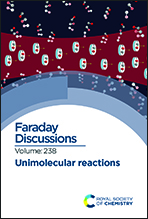Unimolecular dissociation dynamics of electronically excited HCO(Ã2A′′): rotational control of nonadiabatic decay†
Abstract
The photoinduced unimolecular decay of the electronically excited HCO(Ã2A′′) is investigated in a combined experimental–theoretical study. The molecule is excited to the (1, n2, 0) combination bands, which decay via Renner–Teller coupling to the ground electronic state. The rovibrational state distribution of the CO fragment was measured via the high-n Rydberg H-atom time-of-flight method and calculated using a wave packet method on an accurate set of potential energy surfaces. It is shown that the non-adiabatic decay rate is strongly modulated by the HCO rotational angular momentum, which leaves unique signatures in the product state distribution. The experimentally observed bimodal rotational distribution of the dominant CO(v = 0) fragment is likely due to decay of different vibronic states populated by the excitation and modulated by the excited state lifetime, which is in turn controlled by the parent rotational quantum number.

- This article is part of the themed collection: Unimolecular reactions


 Please wait while we load your content...
Please wait while we load your content...